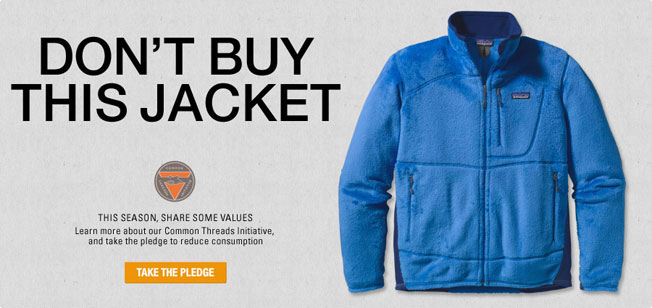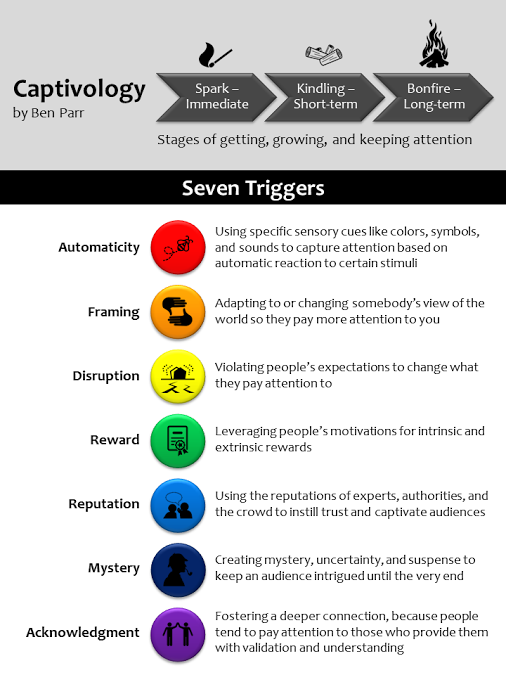
Are you capturing their attention? (designed by Freepik)
Attention is the most important resource in the digital age.
It can also be the hardest to attract in a cluttered and information overloaded world filled with news, ads and content – both online and offline.
As a marketer, however, you cannot afford to wait till your customers discover you. “Build it and they’ll come,” is definitely pure folly in today’s hyper-distracted age.
Thankfully venture capitalist and former Mashable editor Ben Parr provides a few good answers in his book Captivology – The Science of Capturing People’s Attention.
Author of Captivology Ben Parr (courtesy of Brass Check)
Let’s dive right away into the gems in this slim volume.
Three Stages of Attention
At the start of the book, Ben used the metaphor of a fire to describe our audience’s attention. The goal is to lead them through the three stages of attention, namely:
- Immediate Attention (aka “Spark”): Igniting attention through triggering gut responses. For example, calling out somebody’s name.
- Short-Term Attention (aka “Kindling”): Actions that can trigger dopamine release in your audiences, and that helps them to focus. Novelty helps here. Resides in your short-term memory.
- Long-Term Attention (aka “Bonfire”): Ability to focus your attention and interest for prolonged period of time. Familiarity is the key here. Resides in tour long-term memory.
To do so, Ben provided seven triggers to consider.
#1 Automaticity Trigger
Using specific sensory cues like colours, symbols and sounds to capture attention based on our automatic reaction to certain stimuli.
Our brains depend on salient sensory cues to warn us of danger and alert us to new situations that require our attention. Fight or flight syndrome?
- Use different colours to capture attention (eg red for romance, blue for competence) and play with contrasts to stand out
- Use distinctive symbols. For example the Heartbleed bug (CVE-2014-0160) received a lot of attention because of its unique name and symbol. An example of the priming effect.
- Use the sense of touch. For example, buying somebody warm coffee is likely to improve your outcomes.’
- Use the person’s name. This is known as attenuation theory (ie selective attention).
- Use the right sounds. For example the use of military equipment and explosion sounds by the “Ghost Army” (23rd Headquarters Special Troops) fooled Hitler’s forces into thinking it was a fearsome force!
Courtesy of Heartbleed.com
#2 Framing Trigger
Adapting or changing somebody’s view of the world (ie frames of reference) so that they pay more attention to you. Our frames are usually formed by experience, biological wiring, cultural expectations, interests, opinions and current moods.
To do so, consider your audience’s frame of reference, understand their concerns, find common ground, know their cultural norms and traditions. You may also wish to set the agenda by repetition so that you can set up an illusion-of-truth effect (people tend to believe what they see or hear frequently).
Reframing can also come through triggering the Fear Of Missing Out (FOMO) or scarcity effect. This strategy is often used in advertisements, eg “Limited Stock Only”, “2 Days Only!”
Reframing example – Odorono
In early 1900s, antiperspirants and deodorants were not popular as people thought blocking sweat was unhealthy and that it was uncouth to talk about bodily functions. However, this changed when teenage Edna Murphey borrowed US$150 from her grandfather and launched her antiperspirant Odorono in 1910.
With the help of J. Walter Thompson’s copywriter James Webb Young, she tackled the claim that stopping perspiration was unhealthy by showing how it was developed by a doctor. This doubled sales. In 1919, the real shift came with the ad:
Many a woman who says, “No, I am never annoyed by perspiration,” does not know the facts – does not realise how much sweeter and daintier she would be if she were entirely free from it.
This ignited some controversy but also help sales of Odorono to skyrocket. By 1927, it broke US$1 million!
#3 Disruption Trigger
Disruption is about changing the status quo. It is an event like a person’s behaviour or change in environment which violates our expectations of how the world should work.
To trigger disruptive attention, consider the following three Ss:
- Surprise: Introduce a surprise element in your communication.
- Simple: Keep your ideas simple and easier to understand, eg Steve Jobs and the iDVD. Quoting from Captivology: “Here’s the new application. It’s got one window. You drag your video into the window. Then you click the button that says burn. That’s it. That’s what we’re going to make.”
- Significant: Make sure that you make the disruption meaningful, relevant and salient to your audience.
Examples of Disruption
A great example cited by the book was that of Patagonia telling customers “DON’T BUY THIS JACKET” in its ad for Black Friday 2011, explaining that it uses 135 litres of water – enough for a person to live off of for 45 days. The ad actually helped Patagonia’s sales to skyrocet by 40 percent in two years because it disrupted our expectations for how a brand is supposed to act on Black Friday.
Courtesy of Adweek
The Old Spice Guy is another great example of disruption, covering the three elements of surprise, simplicity, and salience.
Source: Frat House Sports
#4 Reward Trigger
All humans seek rewards like food, sex, or other forms of pleasure. This comes in two parts.
The first system – wanting – is the system that gives us motivation to act and is powered by dopamine. It gives us desire. The second – liking – is the system that provides the actual reward itself, hence completing the reward cycle.
Extrinsic Rewards
These are tangible rewards which we receive like money, food, trophies and high test scores. They are good for immediate and short attention. There are six forms of external rewards based on principles of gamification:
- Incentives – We’ll reward you if you complete the stamps
- Post-action rewards – Provide reward only after completion
- Collections – Example of McDonald’s “Hello Kitty” dolls!
- Lottery – Strike and you are rich!
- Random Rewards – Surprises work well!
- Gifting – We love gifts
Intrinsic Rewards
These can be a lot more powerful over the long-term. They are useful for capturing long attention and build loyalty. These are intangible rewards that provide us with feelings of internal satisfaction and accomplishment.
To deliver intrinsic motivators, consider Daniel Pink’s three key motivations:
- Autonomy: freedom of self-direction
- Mastery: becoming better at something
- Purpose: knowing why you’re doing something
Examples include Google’s 20 percent – where engineers can spend up to one day a week on pet projects, and the Terry Fox Run where participants felt inherently joyful in supporting an underdog like Fox.
Courtesy of Terry Fox Foundation
#5 Reputation Trigger
This next trigger looks at using the reputations of experts, authorities and the crowd to instill trust and captivate your audiences. It rides on the fact that we rely on reputable sources to direct our scarce attention.
You can consider the following strategies to use the reputation trigger:
- Employ an expert to substantiate your claims. For example, a doctor, engineer, fashion designer, or scientist.
- Work with a person of authority or borrow his or her influence (or use your own). They can have rational-legal authority (eg governments), traditional authority (eg emperors and monarchies), or charismatic authority (eg heroes, leaders).
- Tap the wisdom of the crowds. This can be done through ways to establish social proof, for example by showing how many customers you have, or testimonials.
Robert Galbraith to J K Rowling
Have you heard of Robert Galbraith? Well neither have I.
Releasing his first crime fiction novel The Cuckoo’s Calling in April 2013, it sold a paltry 1500 print copies and a few thousand more e-books.
However, that all changed on July 2013 when it was revealed that Robert Galbraith was actually J.K. Rowling, the world famous author of Harry Potter books. That immediately caused sales of the book to jump by 156,866 percent, and rise from 4,709 on Amazon’s best-selling books to number one.
#6 Mystery Trigger
Creating mystery, uncertainty, suspense and cliffhangers helps to keep your audience intrigued until the very end. This is the reason why we follow the Harry Potter and Star Wars series of movies (and books).
The mystery trigger is the tactical use of unfinished mysteries to capture the attention of your audiences. It is the linked to our proclivity to reduce uncertainties (ie uncertainty reduction theory) and our ability to keep something top-of-mind until it is resolved (aka The Zeigarnik Effect).
The successful use of mysteries lies in four components:
- Suspense: The emotional state of excitement, apprehension and tension when a mystery is yet to be resolved.
- Emotional Buy-In: We feel more strongly for characters and situations that we can identify and resonate with.
- Plot Twist: Nothing beats a plot twist to captivate us and keep us on our toes. Perhaps the most famous in movie history would be the fact that Darth Vader was Luke Skywalker’s father!
- Cliff-Hanger: Employed by television series like Lost to keep us continually on our toes until the next episode.
#7 Acknowledgement Trigger
This trigger helps to sustain long-term attention and focuses on forming deeper connections with your community. It describes our innate need for…
- Recognition: Do you know my name? Do you know that I exist?
- Validation: Do you think I’m special, unique, or important?
- Empathy: Do you feel what I feel? Do you care about or understand me?
Recognition and fame are inter-twined. It is the reason why people are so interested in shows like The Voice or American Idol.
Validation is a strategy used by Buzzfeed, where they intentionally appeal to the various identities of its audiences. For example, an article title “21 Questions Asian People Are Sick of Answering” would appeal to Asians and validate them.
Empathy works more strongly when we can identify a specific individual that we’re helping, rather than a bunch of facts and statistics. Here are two examples from the Captivology book. Guess which worked better?
| Example 1 | Example 2 |
| Food shortages in Malawi affect more than three million children. In Zambia, severe rainfall deficits resulted in a 42% drop in maize production from 2000. As a result, an estimated three million Zambians face hunger… | Any money that you donate will go to Rokia, a seven-year-old girl who lives in Mali in Africa. Rokia is desperately poor and faces a threat of severe hunger, even starvation. Her life will be changed for the better as a result of your financial gift… |
How AKB48 Aces Acknowledgement
Generating over US$225 million in sales in 2012, AKB48 from Japan is one of the best-selling musical acts in the world.
Unlike other musical acts, they do not have a lead singer, and members graduate from the group in their early to mid-twenties. There are between 80 to 95 members (known as “idols”) in the group, and they are expected to be kawaii (cute and adorable) and role models.
The secret of AKB48 lies in how they exemplify the values of their fans and feel real and genuine – even if the relationship is one-sided. Also known as a parasocial relationship – one where one person knows a lot about another person, but the other doesn’t know anything about the first – it is commonly used by celebrities.
To do so, AKB48 frequently goes on variety shows to show their personality, and look at the camera in a way to make guys feel special. They also hold events called akushu-kai (handshake meetings) to shake the hands of their fans. Another way of generating fan involvement is the sousenkyo (general election) where fans have the power to support their favourite performers or boot them out.
Ready to Capture Some Attention?
Steeped in the science of psychology and laced with numerous examples, Captivology ranks as one of the best books that I’d recommend for content marketers anywhere in the world.
Addressing an important need in our attention-starved world, it provides us with a great framework to think about how we could capture immediate, short-term and long-term attention of our audiences.
Finally, here’s a useful infographic for those who need a handy mnemonic device for the principles in the book.
Courtesy of @valarywithawhy










